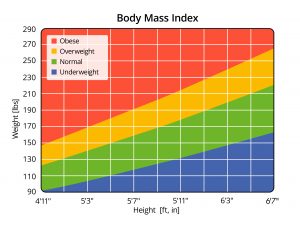Surabhi Tewari, BS, and Olivia H. Chang, MD, MPH
Obesity_FFHA2019
Being overweight and obese are conditions where people have a higher weight than their ideal, healthy weight. These conditions affect people of all ages across the world. Over 71% of adults in the United States are classified as overweight or obese.
It is important to know about the risk factors for obesity, the negative health effects of obesity, and strategies to manage weight.
How do I know if I am overweight?
The “Body Mass Index (BMI)” scale is most often used to classify weight. This scale shows a ratio of your height and weight to see if your current weight is in the ideal range for your height. BMI can help both you and your health care provider monitor your weight.
The BMI Scale has four categories:
- BMI less than 18.5 is the underweight range
- BMI between 18.5-25.0 is normal weight
- BMI between 25.0-30.0 is in the overweight range
- BMI greater than 30.0 is considered obese
Obesity can be further categorized into three classes:
- Class 1: BMI between 30-35
- Class 2: BMI between 35-40
- Class 3: BMI greater than 40 (extreme or severe obesity)
You can use the CDC’s “Adult BMI Calculator” to calculate your own BMI: https://www.cdc.gov/healthyweight/assessing/bmi/adult_bmi/english_bmi_calculator/bmi_calculator.html
What are factors that lead to being overweight or obese?
Obesity is a complex disease that is impacted by many different factors. In the past it was believed that diet and exercise are the only contributors to obesity. But we now know that obesity is affected by the interactions between individual actions, biology, and the environment.
 Individual Actions
Individual Actions
To put it simply, obesity is caused by taking in more calories than the number of calories being used. The calories “in” are based on the foods that we eat. The calories “used” are influenced by overall activity level and exercise.
There are many factors that lead to eating more than the needed amount, including:
- Not knowing which foods are high in calories
- Eating out in large groups or at certain events
- Emotional eating, such as eating when stressed, depressed or anxious
- Snacking
- Not enough sleep
- Hunger can be a side-effect of some medications
- Stopping the use of drugs such as coffee and nicotine
Similarly, many factors lead to physical inactivity, including:
- Social pressures to remain inactive (for example, desk jobs generally pay higher than outdoor work)
- Medical barriers (tiredness/chronic fatigue, muscle and joint pain, fibromyalgia, cardiorespiratory disease)
- Emotional barriers (worried about what other people will think, being fearful of judgment, depression, other responsibilities such as childcare)
Biological Processes
Recently, there has been more interest in looking at the biological factors that influence weight gain. These biological factors include genetic differences between people. There is also the interaction of genetics and the environment (epigenetics) and how the body communicates to the brain about hunger. There is still a lot to learn about these factors, but researchers are now understanding that biology, in addition to individual choices, plays a major role in weight gain and management .
Environment
The environment surrounding you can have an impact on weight. Higher rates of obesity are typically seen in disadvantaged communities. For example, more fast food restaurants and less grocery stores are in these communities, and this can make it more difficult to eat fresh fruits and vegetables. Poor public transportation makes it harder to access grocery stores and visit the doctor. Fewer parks and safe walking areas can make more difficult to be active. These factors, in combination with lifestyle, can make it more difficult to manage weight.
What are some health concerns related to obesity?
Obesity increases the risk for many different diseases, including:
- Type II Diabetes
- High Blood Pressure
- Heart Attack
- Stroke
- Joint pain/osteoarthritis
- Alzheimer disease
- Mental illness (clinical depression, anxiety)
- Some cancers (breast, ovarian, liver, kidney, colon)
How is obesity related to type II diabetes?
Type II diabetes is a chronic illness in which the body is not able to make or respond to insulin. This keeps the body from using the sugar from food for energy and leads to high blood sugars. There are many ways obesity and type II diabetes may be related. Inflammation from excess fat tissue may lead to insulin resistance. Fat deposits in the abdominal area can also lead to insulin resistance. It is also possible that overeating can lead to both weight gain and keep the body from using glucose efficiently.
How is obesity related to high blood pressure, plaque build-up, and heart disease?
When there is more fat in the body, there is more mass to which the heart has to deliver blood. This can cause the heart to have to pump harder and faster than it should, leading to more pressure on the walls of the arteries. This can lead to an overall increase in your blood pressure. Also, the increased work that the heart has to do to pump blood can cause the heart to become weaker over time. Excess nutrients and fat can also build up in the walls of arteries. This buildup makes it harder for the heart to pump blood to different parts of the body. The arteries that supply the brain can get blocked, leading to stroke. Also, the arteries that supply the heart with blood can get blocked with fatty plaque build-up, which is called coronary artery disease. This blockage can lead to chest pain or a heart attack.
How is obesity related to joint pain?
People who are obese have to bear excess body weight, and this can cause cartilage in between bones (especially the knee joint) to wear down. Obesity can also lead to joint pain and osteoarthritis in non-weight bearing joints. Researchers have also found that hormones secreted from fat tissue are involved in the buildup and break down of cartilage between bones. Having too much fat tissue may break down cartilage in between joints.
How is obesity related to cancer?
People who are obese are more likely to develop certain cancers, including endometrial cancer, breast cancer, and ovarian cancer. In a study in 2012, it was estimated that nearly 10% of cancers in women and 4% of cancers in men can be attributed to being overweight or obese. Some research shows that the increased inflammation from obesity may have something to do with cancer risk, but there is still a lot of research needed in the field to understand exactly how cancer and obesity are related.
What are ways to manage weight?
Even though weight gain is not related to individual choices only, you can make some healthy lifestyle changes to manage your weight and decrease your risk for obesity-related diseases. The American Cancer Society focuses on three key lifestyle modifications to manage weight:
- Engage in frequent and consistent physical activity
- Maintain a balanced diet with healthy foods
- Decrease or eliminate alcohol consumption
Engage in frequent and consistent physical activity
Physical activity is important for all age groups to manage weight. For adults, it is recommended to exercise for at least 150 minutes with moderate intensity or 75 minutes with vigorous intensity every week. Examples of moderate intensity exercise include:
- Brisk walking (2.5 miles per hour)
- Water aerobics
- Dancing (ballroom or social)
- Gardening
- Tennis (doubles)
- Biking slower than 10 mph
Vigorous activities are those that require more effort, and it is likely that you will get warm and sweaty from these exercises. Examples of vigorous intensity exercises include:
- Hiking uphill
- Running
- Swimming laps
- Aerobic dancing
- Heavy yardwork (digging or hoeing)
- Tennis (singles)
- Cycling faster than 10 miles per hour
- Jumping rope
Children and adolescents should spend at least one hour per day doing moderate or vigorous intensity exercises. In addition, children and adolescents should exercise at least three times a week with vigorous intensity.
Although it can be difficult to start exercising or increasing your goal to 150 minutes of exercise per week, it is important to remember that any level of exercise is better than no exercise. Even if you start with small steps, you can work up to your goal. If you have questions about how to add exercise into your daily routine, talk to your health care provider to learn more about what the best type of activity is for your health needs.
Maintain a balanced diet with healthy foods
Having healthy eating habits can both help manage weight and decrease the risk for different obesity-related diseases. Healthy eating does not mean only eating fewer calories. It is just as important to pay attention to the types of food that you are eating. Some recommendations include:
- Making half of your plate fruits and vegetables
- Making half of your grains whole grains (i.e. avoiding processed grains such as white bread)
- Eating low-fat or fat-free dairy products
- Getting protein from a variety of sources, including meat, poultry, seafood, beans, eggs, nuts and seeds
There are also certain diets that have been found to be “heart healthy.” One example is the Mediterranean Diet, which consists of a large  number of:
number of:
- Fruits and vegetables
- Nuts
- Legumes
- Whole wheat bread
- Fish
- Olive oil
The United States Department of Agriculture has many resources to help you determine how many calories you should be eating based upon your age, gender, and level of activity. There is also information about ways to eat healthy on a budget and sample recipes to get help you get started with eating healthier. These resources can be found at https://www.choosemyplate.gov/.
Decrease or eliminate alcohol consumption
Drinking has been linked to fat accumulation in men and women, especially binge drinking and heavy drinking. This may be due to the excess calories from alcohol, especially in calorie heavy drinks such as beer. Plus, drinking alcohol can stimulate your appetite, causing you to eat excessive calories. Alcohol can also disrupt signals between your brain and the rest of the body about satiety (or how “full” you feel), causing you to eat too much.
It is recommended that women should limit their alcohol usage to no more than one drink per day. Men should limit their alcohol usage to no more than two drinks per day. A drink is classified as:
- 12 fluid ounces of a regular beer (5% alcohol)
- 8-9 fluid ounces of malt liquor (7% alcohol)
- 5 fluid ounces of table wine (12% alcohol)
- 1.5 fluid ounces shot of distilled spirits (40% alcohol)
What are other, non-lifestyle changes to manage weight?
Some people may be eligible to try other medical options to address their weight. Currently, there are FDA approved drugs for people who are obese and have at least one other related disease or condition, such as diabetes. It is important to discuss questions about medication for weight loss with your doctor to understand the risks and benefits of these options.
Bariatric surgery is another option for weight loss for people who have severe obesity. The goal of this procedure is to make it easier to manage hunger and weight gain by changing the size of the stomach or intestines. However, there are many strict criteria for bariatric surgery eligibility that should be discussed with your health care provider.
Take Home Points
- Being overweight and obesity are due to many factors, including lifestyle choices, the environment, and biological processes
- There is increased risk for many different diseases due to being overweight or obese
- Control your weight with physical activity and diet (including less alcohol consumption)
- Medical treatment and bariatric surgery are two options for weight reduction for some people
References
- Centers for Disease Control and Prevention. Overweight and Obesity. CDC.gov. 2019 August 21.
- Tergas AI, Wright JD. Cancer Prevention Strategies for Women. Obstet Gynecol 2019;134(1):30–43.
- Blüher M. Obesity: global epidemiology and pathogenesis. Nature Reviews Endocrinology 2019;15(5):288–98.
- Sharma AM, Padwal R. Obesity is a sign – over-eating is a symptom: an aetiological framework for the assessment and management of obesity. Obesity Reviews 2010;11(5):362–70.
- Algoblan A, Alalfi M, Khan M. Mechanism linking diabetes mellitus and obesity. DMSO 2014;587.
- Eckel RH, Kahn SE, Ferrannini E, et al. Obesity and type 2 diabetes: what can be unified and what needs to be individualized? J Clin Endocrinol Metab 2011;96(6):1654–63.
- Jiang S-Z, Lu W, Zong X-F, Ruan H-Y, Liu Y. Obesity and hypertension. Experimental and Therapeutic Medicine 2016;12(4):2395–9.
- Pottie P, Presle N, Terlain B, Netter P, Mainard D, Berenbaum F. Obesity and osteoarthritis: more complex than predicted! Annals of the Rheumatic Diseases 2006;65(11):1403–5.
- National Cancer Institute. Obesity and Cancer. Cancer.gov. 2019 August 21.
- American Heart Association. American Heart Association Recommendations for Physcial Activity in Adults and Kids. Heart.org. 2019 August 21.
- Traversy G, Chaput J-P. Alcohol Consumption and Obesity: An Update. Curr Obes Rep 2015;4(1):122–30.
- National Institute on Alcohol Abuse and Alcoholism. What is a Standard Drink? NIAAA.org. 2019 August 21.
Author Information

Surabhi Tewari, BS, graduated from The Ohio State University in 2018. She is now a medical student at Lerner College of Medicine of Case Western Reserve University in Cleveland, OH. No conflicts of interest to report.

Olivia H. Chang, M.D., M.P.H. graduated from Tulane University School of Medicine and completed her OB/GYN residency at Beth Israel Deaconess Medical Center in Boston, MA. She is now a fellow in Female Pelvic Medicine and Reconstructive Surgery at the Cleveland Clinic in Cleveland, OH. No conflicts of interest to report.






